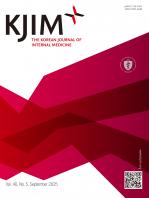|
Gastroenterology / Original Article
Trends in Helicobacter pylori eradication rates by first-line triple therapy and related factors in eradication therapy
Sung Eun Kim, Moo In Park, Seun Ja Park, Won Moon, Youn Jung Choi, Ji Hyun Cheon, Hye Jung Kwon, Ki Hwan Ku, Chang Hun Yoo, Jae Hyun Kim, Gyu Won Lee, Sung Eun Song
Korean J Intern Med. 2015;30(6):801-807. Published online October 30, 2015
Background/Aims: Trends in successful eradication of Helicobacter pylori using first-line triple therapy, consisting of a proton pump inhibitor, amoxicillin, and clarithromycin, have been understudied. We evaluated H. pylori eradication rates at a single center over the last 10 years a..
|
|
|
Gastroenterology / Review
A systematic approach for the diagnosis and treatment of idiopathic peptic ulcers
Chen-Shuan Chung, Tsung-Hsien Chiang, Yi-Chia Lee
Korean J Intern Med. 2015;30(5):559-570. Published online August 27, 2015
An idiopathic peptic ulcer is defined as an ulcer with unknown cause or an ulcer that appears to arise spontaneously. The first step in treatment is to exclude common possible causes, including Helicobacter pylori infection, infection with other pathogens, ulcerogenic drugs, and uncommon dise..
|
|
|
Gastroenterology / Review
Roadmap for elimination of gastric cancer in Korea
David Y. Graham
Korean J Intern Med. 2015;30(2):133-139. Published online February 27, 2015
Most gastric cancers are caused by infection with the common human bacterial pathogen, Helicobacter pylori. It is now accepted that gastric cancer can be prevented and virtually eliminated by H. pylori eradication and this knowledge was responsible for country-wide H. pylori era..
|
|
|
Gastroenterology / Review
Current status of functional dyspepsia in Korea
Hyuk Lee, Hye-Kyung Jung, Kyu Chan Huh, Functional Dyspepsia Study Group in the Korean Society of Neurogastroenterology and Motility
Korean J Intern Med. 2014;29(2):156-165. Published online February 27, 2014
Dyspepsia refers to group of commonly occurring upper gastrointestinal symptoms. The majority of patients with dyspepsia suffer from functional (nonulcer) dyspepsia. Although there is a lack of epidemiological data from population-based or patient cohort studies in Korea, the current understanding o..
|
|
|
Gastroenterology / Review
Current evidence of effects of Helicobacter pylori eradication on prevention of gastric cancer
Il Ju Choi
Korean J Intern Med. 2013;28(5):525-537. Published online August 14, 2013
Gastric cancer is the second most common cause of cancer death worldwide and is usually detected at a late stage, except in Korea and Japan where early screening is in effect. Results from animal and epidemiological studies suggest that Helicobacter pylori infection, and subseque..
|
|
|
Original Article
Serum Prohepcidin Levels in Helicobacter Pylori Infected Patients with Iron Deficiency Anemia
Sun-Young Lee, Eun Young Song, Yeo Min Yun, So Young Yoon, Yo Han Cho, Sung-Yong Kim, Mark Hong Lee
Korean J Intern Med. 2010;25(2):195-200. Published online June 1, 2010
Background/AimsHelicobacter pylori (H. pylori) infection appears to subvert the human iron regulatory mechanism and thus upregulates hepcidin, resulting in unexplained iron-deficiency anemia (IDA). We evaluated serum prohepcidin levels before ..
|
|
|
Original Article
Comparison of the 13C-urea breath test and the endoscopic phenol red mucosal pH test in the quantification of Helicobacter pylori infection loading
Young-Seok Cho, Hiun-Suk Chae, Se Na Jang, Jin-Soo Kim, Hye Suk Son, Hyung-Keun Kim, Byung-Wook Kim, Sok-Won Han, Kyu-Yong Choi, Hae Kyung Lee, Eun Deok Chang
Korean J Intern Med. 2008;23(3):134-139. Published online September 20, 2008
Background/AimsThe 13C-urea breath test (UBT) is a semiquantitative test for measuring Helicobacter pylori infection loading. H. pylori produces ammonia, which elevates the pH of the gastric mucosa and is detectable via endoscopy us..
|
|
|
Original Article
Helicobacter pylori Infection and Peptic Ulcer Disease in Patients with Liver Cirrhosis
Dong Joon Kim, Hak Yang Kim, Sung Jung Kim, Tae Ho Hahn, Myoung Kuk Jang, Gwang Ho Baik, Jin Bong Kim, Sang Hoon Park, Myung-Seok Lee, Choong Kee Park
Korean J Intern Med. 2008;23(1):16-21. Published online March 20, 2008
Background/AimsWe investigated the prevalence and relationship of peptic ulcer disease and Helicobacter pylori infection to liver cirrhosis. MethodsWe examined 288 patients with liver cirrhosis, 322 patients w..
|
|
|
Case Report
Duodenal Mucosa-Associated Lymphoid Tissue Lymphoma: A Case Report
Kyung Hee Woo, Jung Han Kim, Seong Bo Yoon, Joo Hyun Jang, Dong Hun Lee, Seong Ho Hong, Il Hyun Baek
Korean J Intern Med. 2007;22(4):296-299. Published online December 20, 2007
Primary duodenal mucosa associated lymphoid tissue (MALT) lymphoma is very rare, and little is known about its clinical course or effective treatment. We describe a case of primary duodenal MALT lymphoma that was resistant to Helicobacter pylori (H. pylori) eradi..
|
|
|
Original Article
The Association Between Current Helicobacter pylori Infection and Coronary Artery Disease
Seung-Won Jin, Sung-Ho Her, Jong-Min Lee, Hee-Jeoung Yoon, Su-Jin Moon, Pum-Joon Kim, Sang-Hong Baek, Ki-Bae Seung, Jae-Hyung Kim, Sang-Bum Kang, Jae-Hi Kim, Keon-Yeop, Kim
Korean J Intern Med. 2007;22(3):152-156. Published online September 30, 2007
BackgroundThe role of Helicobacter pylori (H. pylori) in the pathogenesis of coronary artery disease (CAD) is still controversial, and the relation between current H. pylori infection and CAD has not been fully examined. This ..
|
|
|
Case Report
High-grade Hepatic Mucosa-associated Lymphoid Tissue (MALT) Lymphoma Probably Transformed from the Low-grade Gastric MALT Lymphoma
Yong Woo Chung, Joo Hyun Sohn, Chang Hee Paik, Jae Yoon Jeong, Dong Soo Han, Yong Cheol Jeon, Young Ha Oh
Korean J Intern Med. 2006;21(3):194-198. Published online September 30, 2006
The Mucosa-associated lymphoid tissue (MALT) lymphoma, which was first described in 1983, is known to be caused by chronic Helicobacter pylori (HP) infection, which triggers lymphoid infiltration and formation of organized lymphoid tissue. In approximately two thirds of cases of ..
|
|
|
















